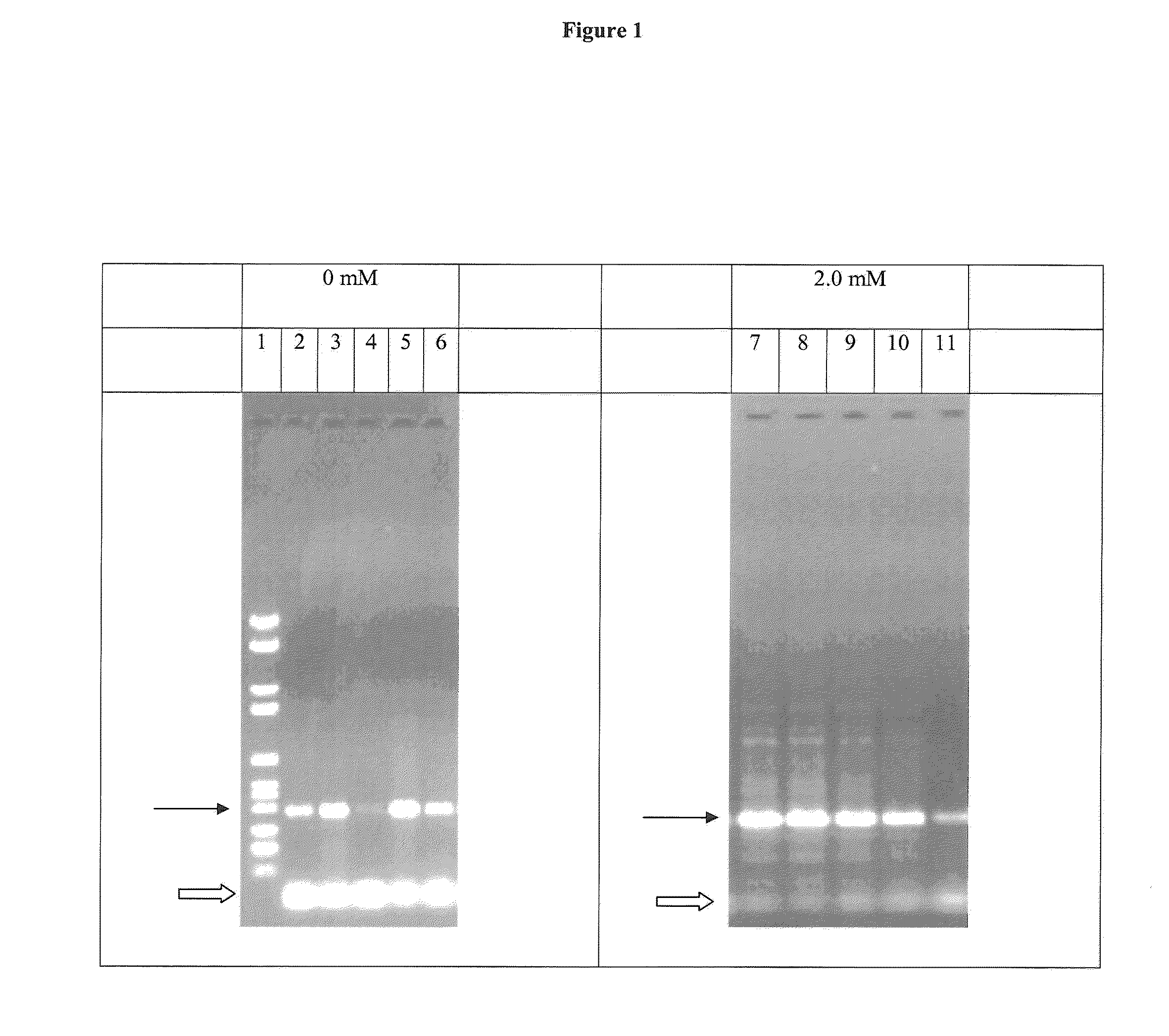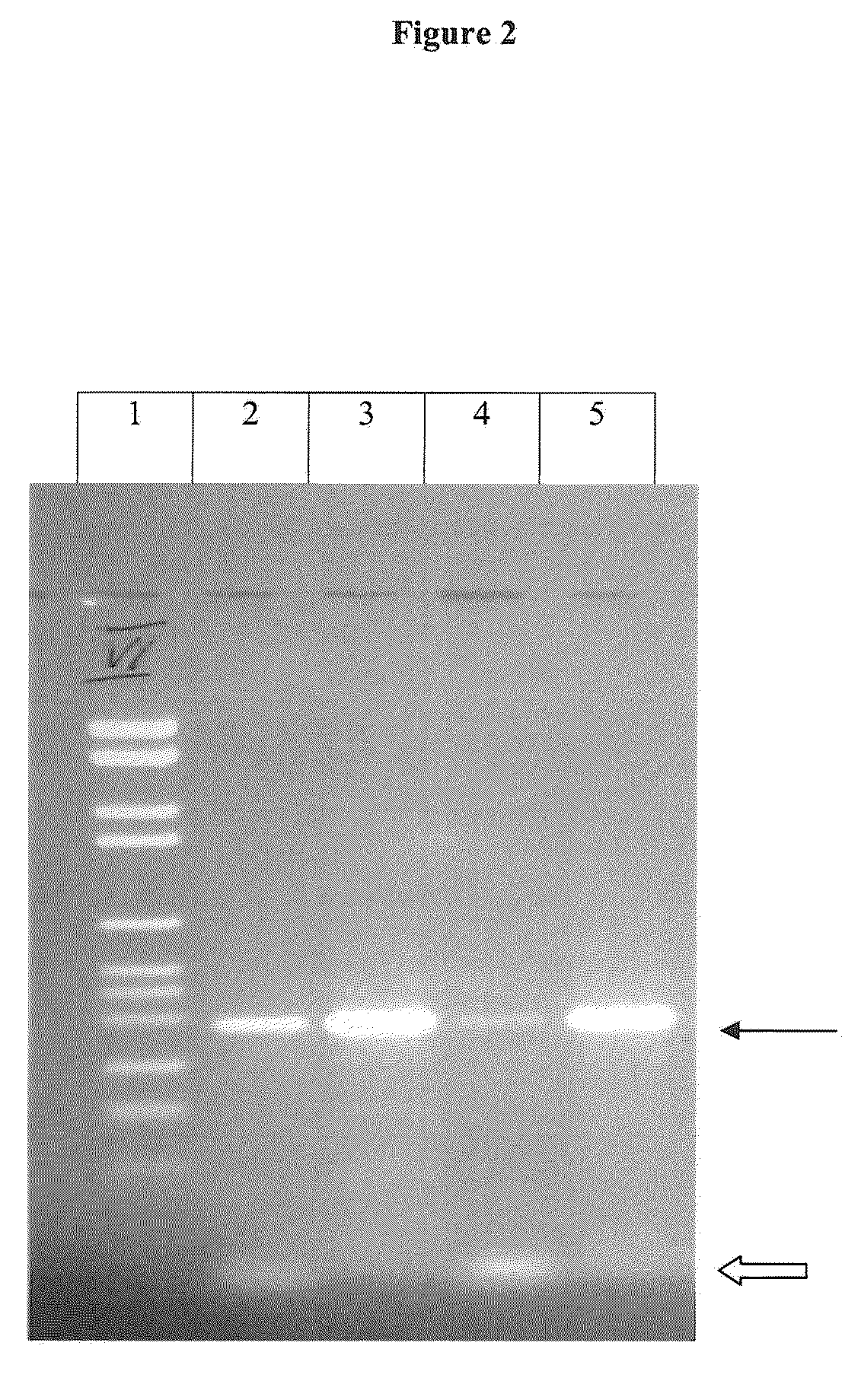PCR hot start by magnesium sequestration
a technology of magnesium sequestration and hot start, which is applied in the direction of peptides, peptides/protein ingredients, transferases, etc., can solve the problems of unspecific amplification products, time-consuming and inconvenient operation, and variability in reproducibility and quality of chemically modified enzyme preparations,
- Summary
- Abstract
- Description
- Claims
- Application Information
AI Technical Summary
Benefits of technology
Problems solved by technology
Method used
Image
Examples
example 1
[0131]A peptide with the sequence H-DIETDIET-NH2 (SEQ ID NO: 9) was synthesized, HPLC purified, lyophilized and dissolved in 30 mM Tris-HCl, pH 8.5. PCR reactions were performed in 50 μl volume containing 50 ng, 25 ng, 10 ng, 5 ng or 1 ng of human genomic DNA, 2.5 units Taq polymerase (Roche Applied Science Cat. No. 11146165001), 0.4 mM forward primer (aga cag tac agc cag cct ca) (SEQ ID No: 1), 0.4 mM reverse primer (gac ttc aaa ttt ctg etc ctc) (SEQ ID NO: 2), 0.2 mM dATP, dCTP, dGTP and dCTP, Taq PCR reaction buffer (Roche Applied Science Cat. No. 11146165001), with and without H-DIETDIET-NH2-peptide (SEQ ID NO: 9). The PCR was performed as follows: 2 min at 94° C., 35 cycles with 10 sec at 94° C., 30 sec at 60° C. and 30 sec at 72° C. and a final elongation step over 7 mM at 72° C. The PCR products were analyzed by agarose gel electrophoresis.
[0132]As it can be seen in FIG. 1, addition of 2.0 mM of the disclosed peptide results in a significant decrease of generation of primer / d...
example 2
[0133]Analysis of a peptide with the sequence H-FDGDFDGD-NH2 (SEQ ID NO: 10). PCR reactions were performed in 50 μl volume containing 25 ng or, 10 ng of human genomic DNA, 2.5 units Taq polymerase (Roche Applied Science Cat. No. 11146165001), 0.4 mM forward primer (aga cag tac age cag cct ca) (SEQ ID NO: 1), 0.4 mM reverse primer (agt atg ccc ccg cac agg a) (SEQ ID NO: 3), 0.2 mM dATP, dCTP, dGTP and dCTP, Taq PCR reaction buffer (Roche Applied Science Cat. No. 11146165001), with and without H—FDGDFDGD —NH2-peptide (SEQ ID NO: 10). The PCR cycling conditions were as follows: 2 min at 94° C., 35 cycles with 10 sec at 94° C., 30 sec at 60° C. and 30 sec at 72° C. and a final elongation step over 7 mM at 72° C. The PCR products were analyzed by agarose gel electrophoresis.
[0134]As it can be seen in FIG. 2, addition of 3 mM H-FDGDFDGD-NH2 (SEQ ID NO: 10) results in decreased primer / dimer product formation. In parallel an increase of the specific product formation is observed.
example 3
[0135]The peptide with the sequence H-DIETDIET-NH2 (SEQ ID NO: 9) was analyzed in real time RT-PCR. PCR reactions were performed in 20 μl volume containing 102, 103, 104, 105 and 106 copies of RNA standard available in the LIGHTCYCLER (Roche Diagnostics GmbH) h-G6PDH Housekeeping gene kit from Roche Applied Science (Cat. No.: 3261883), 2.4 units Transcriptor and 1.6 units FastStart polymerase, reaction buffer from the LIGHTCYCLER RNA Amplification Kit SYBR Green (Roche Applied Science Cat. No. 12 015 137 001), 0.5 mM forward primer (ggg tgc atc ggg tga cct g) (SEQ ID NO: 4), 0.5 mM reverse primer (age cac tgt gag gcg gga) (SEQ ID NO: 5), with and without 1 mM H-DIETDIET-NH2-peptide (SEQ ID NO: 9). The PCR was performed in a LIGHTCYCLER 2.0 as follows: 10 min at 55° C., 10 min at 95° C., 45 cycles with 10 sec at 95° C., 10 sec at 55° C. and 13 sec at 72° C.
[0136]The result of this example is shown in FIG. 3. It illustrates that a magnesium binding peptide reduces primer-dimer formati...
PUM
| Property | Measurement | Unit |
|---|---|---|
| Time | aaaaa | aaaaa |
| Thermal stability | aaaaa | aaaaa |
Abstract
Description
Claims
Application Information
 Login to View More
Login to View More - R&D
- Intellectual Property
- Life Sciences
- Materials
- Tech Scout
- Unparalleled Data Quality
- Higher Quality Content
- 60% Fewer Hallucinations
Browse by: Latest US Patents, China's latest patents, Technical Efficacy Thesaurus, Application Domain, Technology Topic, Popular Technical Reports.
© 2025 PatSnap. All rights reserved.Legal|Privacy policy|Modern Slavery Act Transparency Statement|Sitemap|About US| Contact US: help@patsnap.com



